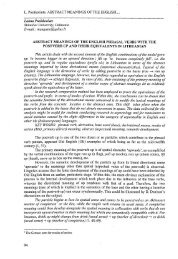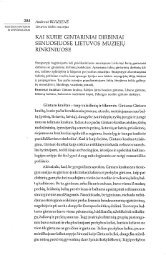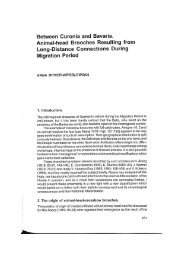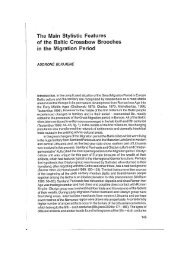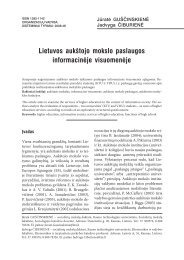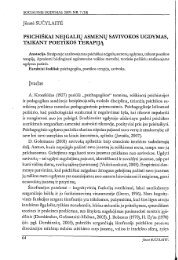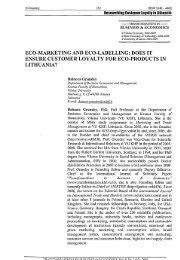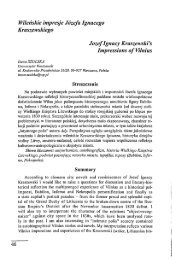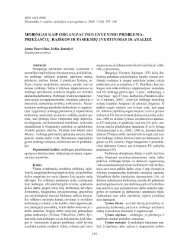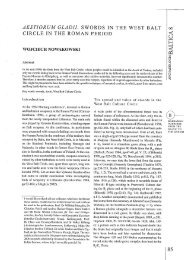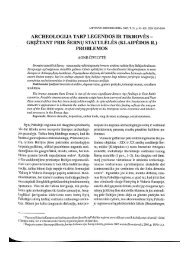NAUJA ŽVĖRUNOS-MEDEINOS PERSPEKTYVA
NAUJA ŽVĖRUNOS-MEDEINOS PERSPEKTYVA
NAUJA ŽVĖRUNOS-MEDEINOS PERSPEKTYVA
Create successful ePaper yourself
Turn your PDF publications into a flip-book with our unique Google optimized e-Paper software.
Churches, were sites of the Zveruna-Medeina cult exercised<br />
by warriors-hunters. The typical repeated element<br />
of cultural environment for Wolf-footprints was<br />
a Sovereign's estate, state castles of the 14—15th centuries<br />
and place-names related to noblemen's estates.<br />
This fact allows to state that Wolf-footprinted stones<br />
signified dependence to the domain of goddess<br />
Zveruna-Medeina. On other part, by use of a mythic<br />
code, the real domains of the Great Duke and noblemen-persons<br />
with status of warriors-hunters - might<br />
have been marked in this way.<br />
Therefore, the goddess Zveruna-Medeina representing<br />
priority activities of the ruling military elite - the hunting<br />
(war), undoubtedly was ranked as a State's -<br />
Sovereign's goddess and therefore was accepted as one<br />
of them. This original trait of the Lithuanian religion may<br />
be explained in the following way:<br />
1) Zveruna-Medeina was famous for her mythic and<br />
religious significance for warriors. Her members were<br />
believed to be also beekeepers - friends who kept bees in<br />
woods (an old Lithuanian institute of relationship where<br />
friendship is based not on blood ties, but on bees shared<br />
among themselves);<br />
2) A particular heed was paid to Zveruna-Medeina<br />
and her cult in the religious tradition followed by the<br />
kin of Mindaugas who was already forming the State.<br />
The main area of Zveruna-Medeina sacred sites, called<br />
as Hare Churches and Wolf-footprints, between the<br />
Nemunas and Neris Rivers coincides with an imaginary<br />
territory of the land of Lithuania (in narrow sense) and<br />
correlates with the geography of early royal estates and<br />
state castles.<br />
Fig. 1. Gotland.<br />
LIST OF ILLUSTRATIONS<br />
Fragments from pictures on stones, representing a<br />
horseman with falcon and dog: 1. Klinte; 2. Garda (according<br />
to: GB, 1941, Table 55; 1942, p. 46).<br />
Fig. 2. Curonia, the 11—12th centuries.<br />
Sword pommel and crosspiece representing hares<br />
scattered in all sides. Simalciems burial ground, Ventspils<br />
district (according to: Latvijas arheologija, 1974, Table<br />
47:12).<br />
Fig. 3. Image of the Odin's warriors-wolfs on the rune<br />
stone at Lund in Sweden (according to: Roesdahl, 1987,<br />
p. 77).<br />
Fig. 4. Hills called as Hare Churches (2,5), stone (1),<br />
field (3), forest (4) (according to the Author): 1. Genionys<br />
(Varėna district); 2. Guronys (Kaišiadorys district); 3.<br />
Liciškėnai (Prienai district); 4. Mičionys (Anykščiai district);<br />
5. Purveliai (Anykščiai district).<br />
Stones with wolf-footprints (3-9,12) and sites called<br />
as Wolf-footprints (1, 2, 10, 11) (according to the Author):<br />
1 -Benekainiai countryside (Beniakoni, Voranavo<br />
district, Byelorussia); 2 - Čižiškės (Utena district); 3 -<br />
Gudeliai (Molėtai district); 4 - Guronys (Trakai district);<br />
5 - Jakėnai (Varėna district); 6 - Kalviai (Rokiškis district);<br />
7 - Kareivonys (Kaišiadorys district); 8 - Sabališkės<br />
(Prienai district); 9 - Vilkpėdė (Vilnius town); 10 -<br />
Vilkapėdžiai (Wilkopedzie, Suvalkai woewodstwo, Polish<br />
Republic); 11 - Žostautai (Kaišiadorys district); 12 -<br />
Žurovecas (Zhuravets, Asipoviczy district, Byelorussian<br />
Republic).<br />
Fig. 5. Genionys, Varėna district. Stone called as a<br />
Hare Church.<br />
Fig. 6. Guronys, Kaišiadorys district. Hare Church<br />
otherwise Grave of Pajauta.<br />
Fig. 7. Liciškėnai, Prienai district, Popšai hill otherwise<br />
a Hare Church.<br />
Fig. 8. Purveliai, Anykščiai district. Pinewood at the<br />
Šventoji River, called as a Hare Church.<br />
Fig. 9. Guronys, Trakai district. Stone with wolf-footprints.<br />
Fig. 10. Site of stone in Vilkpėdė, Vilnius (in the second<br />
ground, near the utility poles).<br />
Fig. 11. Žostautai, Kaišiadorys district. Site of a small<br />
swamp called as a wolf-footprint.<br />
Fig. 12. Distribution of Hare Churches and Wolf-footprints<br />
between the Nemunas and Neris Rivers.<br />
HOBAfl ITEPCIIEKTHBA }KBEPyHbI-ME#EHHbI<br />
BllKHHTaC BailTKHBHHIOC<br />
Pe3io\ie<br />
Aaniian CTaTLsi npojiojuKaeT jiccjieflOBainiH pejiiinin<br />
JIiiTOBCKoro rocyjjapcTDa n XIII B. (CM., VRB, 2001). Ha<br />
ceii pa3 ona nocBHiueiia noncKy<br />
oTBCTa na Bonpoc,<br />
no'icMy cpcan Goroii rocyaapcTBa n rocyjjapji XIII B.<br />
iiaxojuiTCH Gornmi >KBcpyiia-Mcaci"ina (



